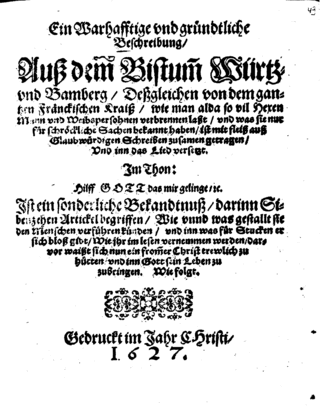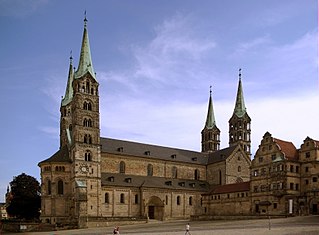
A witch-hunt, or a witch purge, is a search for people who have been labeled witches or a search for evidence of witchcraft. The classical period of witch-hunts in Early Modern Europe and Colonial America took place in the Early Modern period or about 1450 to 1750, spanning the upheavals of the Reformation and the Thirty Years' War, resulting in an estimated 35,000 to 50,000 executions. The last executions of people convicted as witches in Europe took place in the 18th century. In other regions, like Africa and Asia, contemporary witch-hunts have been reported from sub-Saharan Africa and Papua New Guinea, and official legislation against witchcraft is still found in Saudi Arabia and Cameroon today.
Johannes Junius was the mayor of Bamberg, and a victim of the Bamberg witch trials, who wrote a letter to his daughter from jail while he awaited execution for witchcraft.

The Würzburg witch trials of 1625–1631, which took place in the self-governing Catholic Prince-Bishopric of Würzburg in the Holy Roman Empire in present-day Germany, formed one of the biggest mass trials and mass executions ever seen in Europe, and one of the largest witch trials in history.

Hans Christian Erik Midelfort, is C. Julian Bishko Professor Emeritus of History and Religious Studies at the University of Virginia. He is a specialist of the German Reformation and the history of Christianity in Early Modern Europe.

Georg Pictorius of Villingen was a physician and an author of the German Renaissance.
In the early modern period, witch trials were seen between 1400 and 1782, where around 40,000 to 60,000 were killed due to suspicion that they were practicing witchcraft. These trials occurred primarily in Europe, and were particularly severe in some parts of the Holy Roman Empire. Some witch-hunts would last for years, and some sources estimate 100,000 trials occurred. Groundwork on the concept of witchcraft was developed by Christian theologians as early as the 13th century. However, prosecutions for the practice of witchcraft reached a high point only from 1560 to 1630 during the Counter-Reformation and the European wars of religion, with some regions burning at the stake those who were convicted, of whom roughly 80% were women, mostly over the age of 40.

The Witch trials of Fulda in Germany from 1603 to 1606 resulted in the death of about 250 people. They were one of the four largest witch trials in Germany, along with the Trier witch trials, the Würzburg witch trial, and the Bamberg witch trials. The persecutions were ordered by the Catholic Prince Bishop, a follower of the Counter-Reformation. Crypto-protestants were executed on charges of witchcraft.

The Witch Trials of Trier took place in the independent Catholic diocese of Trier in the Holy Roman Empire in present day Germany between 1581 and 1593, and were perhaps the largest documented witch trial in history in view of the executions. They formed one of the four largest witch trials in Germany alongside the Fulda witch trials, the Würzburg witch trial, and the Bamberg witch trials.

The Bamberg witch trials of 1627–1632, which took place in the self-governing Catholic Prince-Bishopric of Bamberg in the Holy Roman Empire in present-day Germany, is one of the biggest mass trials and mass executions ever seen in Europe, and one of the biggest witch trials in history.

The Wiesensteig witch trial took place in Wiesensteig in Germany in 1562–1563. It led to the execution of 67 women for sorcery. This has been described as the first of the great witch trials of Germany and the starting point of the continuing European witch hunt. The trial inspired to the popular book : Of the tricks of Demons, which were printed in six expanded editions in Latin between 1562 and 1583 and translated to French in 1565. It was recorded in 1563 in a pamphlet called "True and Horrifying Deeds of 63 Witches".
Throughout the era of the European witch trials in the Early Modern period, from the 15th to the 18th century, there were protests against both the belief in witches and the trials. Even those protestors who believed in witchcraft were typically sceptical about its actual occurrence.
The Ellwangen witch trial took place in the Catholic Prince Bishopric of Ellwangen between 1611 and 1618. It was preceded by a first witch trial in 1588. The first witch trial led to the death of 17/20 people, and the second led to the death of 430, making the number of deaths to about 450 in total.
Dorothea Flock, was a German woman convicted of witchcraft in Bamberg and a victim of the Bamberg witch trials during the reign of Prince-Bishop Johann Georg Fuchs von Dornheim.

The Eichstätt witch trials was a series of witch trials that took place in the Prince-Bishopric of Eichstätt, Bavaria, Germany, between 1532 and 1723. They resulted in the execution of at least 224 people, and were among the biggest witch trials in Germany. The trials were mainly conducted under the approval of Prince Bishop Johann Christoph von Westerstetten between 1613 and 1630. The last known execution in Eichstätt was conducted in 1723.
Thomas Schreiber was a German innkeeper executed for witchcraft. He was the perhaps best known victim of the Mergentheim witch trials, and became known for his opposition to the witch trials. His correspondence is preserved. His case gives an unusually detailed example of the mentality of a city in the midst of a mass witch trial.
The Esslingen witch trials was a series of witch trials taking place in Esslingen in Germany between 1662 and 1666. It resulted in the death of 37 people. It was the first mass trial of sorcery in South Western Germany in thirty years, and it was also the first large witch trial in Württemberg, a state previously known for its moderation in witch craft persecution. Alongside the Reutlingen witch trials, which took place in parallel, it was the last mass witch trial in South Western Germany.

In the Holy Roman Empire, witch trials composed of the areas of present-day Germany, Switzerland and Austria, were the most extensive in Europe and in the world, both to the extent of the witch trials as such as well as to the number of executions.
Witch trials in Latvia and Estonia were mainly conducted by the Baltic German elite of clergy, nobility and burghers against the indigenous peasantry in order to persecute Paganism by use of Christian demonology and witchcraft ideology. In this aspect, they are similar to the Witch trials in Iceland. They are badly documented, as many would have been conducted by the private estate courts of the landlords, which did not preserve any court protocols.
The Rottenburg witch trials was a series of witch trials taking place in Rottenburg am Neckar in then Further Austria in present day Baden-Württemberg in Germany between 1578 and 1609. It resulted in the death of 150 people. The witch trials were divided in the waves of 1578-1585, 1589-90, 1595-96, 1598-1605 and 1609. The high peak of the trials were the witch trial of 1595-96, when 41 women were burnt alive at the stake between June 1595 and July 1596. Rottenburg were known as a witch trials center and the 1595 trial attracted attention from the University of Tübingen. The Rottenburg witch trials has been characterized as traditional, since the victims were almost exclusively poor old women, and never developed in to the endemic mass trials in which citizens of all sexes and classes could be indiscriminately accused, such as the Würzburg witch trials, and they were conducted under strict control from the authorities.

The Baden-Baden witch trials took place in Baden-Baden in Germany between 1627 and 1631. These witch trials resulted in the deaths of over 200 people; the exact number are uncertain. The trials belonged to the great wave of witch-hunting that took place in southwestern Germany during the Thirty Years' War.







